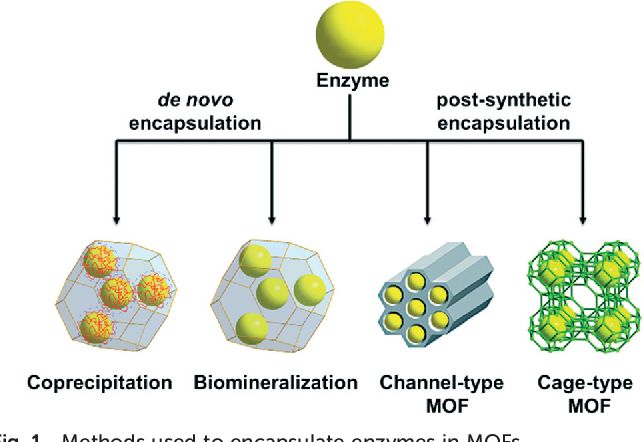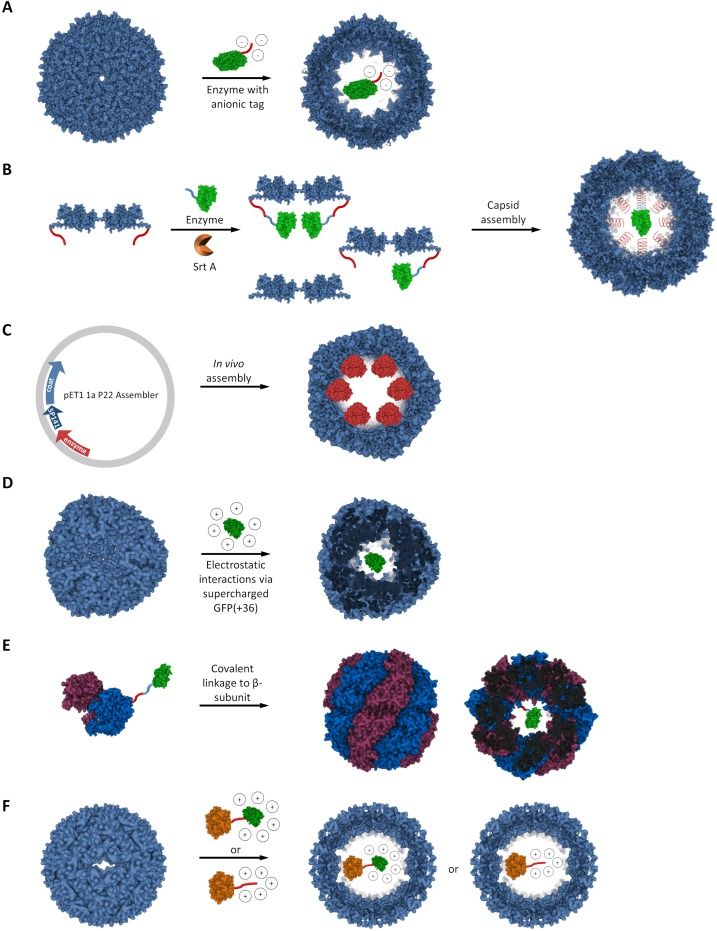Enzyme encapsulation is an innovative technique used to shield enzymes from environmental hazards, thereby enhancing their stability and efficiency. This advanced method helps enzymes retain their activity for a longer duration. It is highly applicable in diverse industrial and medical applications, where enzymes might otherwise deteriorate under harsh conditions. Understanding enzyme encapsulation is crucial as it expands the potential uses of enzymes, augmenting their efficiency and longevity.
 Enzyme encapsulation in metal–organic frameworks for applications in catalysis (M. Majewski, et al., 2017)
Enzyme encapsulation in metal–organic frameworks for applications in catalysis (M. Majewski, et al., 2017)
Service Process
Our company strictly adheres to a meticulously designed, systematic process for enzyme encapsulation, ensuring that we consistently deliver high-quality, reliable results. Our comprehensive process is broken down into several steps, contributing to the overall success of the project:
- Identifying the specific enzyme to be encapsulated. Our team of dedicated scientists and researchers work tirelessly to study and understand the unique properties of the enzyme, ensuring we choose the most suitable one for encapsulation.
- Selection of a suitable encapsulation material. We carefully consider the physical and chemical properties of various encapsulation materials in order to choose the one that will best preserve the functionality and stability of the enzyme.
- Implement the encapsulation process. This involves using specialized equipment and techniques to encapsulate the chosen enzyme within the selected material.
- Testing the stability and activity of the encapsulated enzymes. We conduct rigorous quality control checks and performance tests to ensure that the encapsulated enzymes retain their activity and are stable over time.
- Customize the process according to client requirements. We understand that each client may have unique needs and specifications, and we are flexible in adapting our process to meet these requirements, ensuring a personalized, client-centric approach to our enzyme encapsulation services.
Our team is skilled in using a range of encapsulation techniques and materials, each tailored to meet the specific needs of our clients. If you have any questions, need more information, or would like to discuss a potential project, please don't hesitate to contact us. Our team is always eager to help and share our expertise.
Applications
| Application |
Description |
| Pharmaceuticals |
Enzyme encapsulation in pharmaceuticals revolutionizes drug delivery systems, ensuring controlled release profiles, enhancing stability, and improving the bioavailability of therapeutic agents. This approach enables precise targeting of specific tissues or cells, reducing side effects and optimizing therapeutic outcomes. |
| Food Industry |
Enzyme encapsulation is pivotal in the food industry, offering solutions for enhancing food processing, extending shelf life, and controlling flavor, texture, and nutritional properties. By encapsulating enzymes, food manufacturers can improve the efficiency of processes like fermentation, cheese ripening, and flavor development, while ensuring product consistency and quality. |
| Bioremediation |
Enzyme encapsulation is instrumental in bioremediation efforts, facilitating the degradation of pollutants and environmental cleanup processes. Encapsulated enzymes, deployed in various matrices, exhibit enhanced stability and activity, enabling efficient removal of contaminants from soil, water, and air, thereby contributing to sustainable environmental management and ecosystem restoration. |
| Biomedical Engineering |
In biomedical engineering, enzyme encapsulation serves as a cornerstone for targeted drug delivery, tissue engineering, and biosensing applications. By encapsulating enzymes within biocompatible carriers, researchers can design sophisticated drug delivery systems capable of precise spatial and temporal control, enabling tailored therapies for various diseases and disorders. |
| Textile Industry |
Enzyme encapsulation revolutionizes the textile industry by offering eco-friendly solutions for fabric finishing processes such as dyeing, bleaching, and softening. Encapsulated enzymes facilitate efficient removal of impurities and stains, reducing the need for harsh chemicals and water consumption, while enhancing the overall quality, durability, and sustainability of textile products. |
| Agriculture |
Enzyme encapsulation plays a vital role in modern agriculture, offering solutions for crop protection, soil improvement, and enhancing nutrient uptake. By encapsulating enzymes within nanocarriers or biodegradable polymers, farmers can deliver bioactive compounds directly to plants, promoting growth, resilience against pests and diseases, and improving overall crop yield and quality sustainably. |
| Environmental Science |
Enzyme encapsulation finds diverse applications in environmental science, facilitating wastewater treatment, soil remediation, and pollution mitigation efforts. Encapsulated enzymes exhibit enhanced activity and longevity, enabling efficient breakdown of organic pollutants, toxins, and contaminants, thereby contributing to cleaner waterways, healthier soils, and sustainable environmental stewardship. |
| Cosmetics |
Enzyme encapsulation revolutionizes the cosmetics industry by enabling controlled release of active ingredients in skincare formulations. Encapsulated enzymes enhance product stability, efficacy, and bioavailability, while offering targeted delivery mechanisms for addressing specific skin concerns such as aging, pigmentation, and hydration, thereby elevating the performance and appeal of cosmetic products. |
Case Study
Protein-based enzyme encapsulation leverages naturally occurring shell-forming proteins, including both viral and non-viral capsid proteins. Viral capsids or virus-like particles (VLPs) are particularly notable, forming multimeric protein assemblies with a high degree of symmetry to create hollow shells. These structures have been harnessed extensively for enzyme encapsulation due to their unique properties. The following case study shows a protein-based enzyme encapsulation method. A, Treatment of the bacteriophage MS2 capsid with acetic acid leads to disassembly that can be exploited for the encapsulation of a target enzyme modified with a negatively charged tag. B, pH-dependant dis- and reassembly of the viral capsid from cowpea chlorotic mottle virus (CCMV) in combination with covalent conjugation of the enzyme to the capsid protein using Sortase A (SrtA). C, in vivo enzyme loading by creating fusion constructs with the scaffold protein as demonstrated for bacteriophage P22. D, Encapsulation of supercharged GFP within ferritin via electrostatic interactions. E, Covalent attachment of the enzyme to the β-subunit through a heterobifunctional linker yields enzyme-loaded thermosomes. F, Encapsulation of proteins with a polyarginine or supercharged GFP tag via electrostatic interactions within the self-assembling lumazine synthase.
 Protein-based enzyme encapsulation methods (Friedrich Bialas, et al., 2021)
Protein-based enzyme encapsulation methods (Friedrich Bialas, et al., 2021)
FAQs
Below are commonly asked questions about enzyme encapsulation, covering its definition, importance, process, materials used, impact on enzyme stability and activity, applicability, safety, and procurement. If you have more specific or detailed questions, don't hesitate to get in touch with us directly.
Q: Could you provide a detailed explanation of what enzyme encapsulation is?
A: Of course. Enzyme encapsulation is a highly sophisticated and effective technique that involves safeguarding enzymes from potentially damaging environmental conditions. This is achieved by enclosing the enzymes within a protective barrier. This barrier significantly bolsters their stability and efficiency, ensuring they can perform at an optimal level even in harsh conditions.
Q: Why is it important to study and understand enzyme encapsulation?
A: The study of enzyme encapsulation is of paramount importance because it plays a crucial role in increasing the stability of enzymes, making them more resilient to harsh environmental conditions. This innovative technique expands their applicability in a multitude of industrial sectors and medical fields, making them a versatile tool boasting enhanced effectiveness.
Q: Would you be able to describe the intricate process of enzyme encapsulation?
A: Absolutely. The process of enzyme encapsulation involves the confinement of enzymes within a carrier material. This material acts as a formidable protective shield against the potentially damaging effects of the environment. This process can be customized depending on the unique properties of the enzyme in question, as well as the conditions in which it will be used.
Q: What types of materials are commonly utilized for enzyme encapsulation?
A: A wide variety of materials can be employed for enzyme encapsulation. These include, but are not limited to, polymers, liposomes, and nanoparticles. The selection of the encapsulation material largely depends on the specific enzyme in question and its intended application.
Q: How does enzyme encapsulation contribute to enhancing enzyme stability?
A: Enzyme encapsulation plays a pivotal role in improving enzyme stability. It does this by providing a robust protective barrier. This barrier safeguards the enzyme from potential degradation by external factors, thereby ensuring its longevity and maintaining its effectiveness.
Q: Does the process of enzyme encapsulation have any impact on the enzyme's activity?
A: The primary aim of encapsulation is to preserve and even enhance the enzyme's activity. However, it's imperative that the method and materials used for encapsulation are carefully selected so as to avoid any negative impacts on the enzyme's function.
Q: Can all varieties of enzymes be encapsulated?
A: While a majority of enzymes can indeed be encapsulated, the method and materials chosen for encapsulation may vary depending on the specific properties of the enzyme. Certain enzymes may necessitate specific encapsulation approaches to preserve their functionality.
Q: Could you elaborate on the potential uses of encapsulated enzymes?
A: Encapsulated enzymes boast a wide range of applications. They can be utilized in a variety of fields including but not limited to medicine, biofuel production, food processing, and waste management among others.
Q: Are encapsulated enzymes safe to use?
A: Yes, encapsulated enzymes are generally considered safe to use. However, as with any technological advancement, it's crucial to conduct extensive safety tests for specific applications to ensure they do not pose any risks.
Q: Where could I procure encapsulated enzymes?
A: Our company offers top-notch enzyme encapsulation services. For more detailed information, please don't hesitate to contact us.

































 Enzyme encapsulation in metal–organic frameworks for applications in catalysis (M. Majewski, et al., 2017)
Enzyme encapsulation in metal–organic frameworks for applications in catalysis (M. Majewski, et al., 2017) Protein-based enzyme encapsulation methods (Friedrich Bialas, et al., 2021)
Protein-based enzyme encapsulation methods (Friedrich Bialas, et al., 2021)